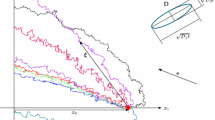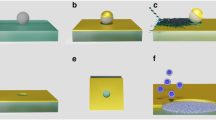Abstract
The narrow escape problem in diffusion theory, which goes back to Lord Rayleigh, is to calculate the mean first passage time, also called the narrow escape time (NET), of a Brownian particle to a small absorbing window on the otherwise reflecting boundary of a bounded domain. The renewed interest in the NET problem is due to its relevance in molecular biology and biophysics. The small window often represents a small target on a cellular membrane, such as a protein channel, which is a target for ions, a receptor for neurotransmitter molecules in a neuronal synapse, a narrow neck in the neuronal spine, which is a target for calcium ions, and so on. The leading order singularity of the Neumann function for a regular domain strongly depends on the geometric properties of the boundary. It can give a smaller contribution than the regular part to the absorption flux through the small window when it is located near a boundary cusp. We review here recent results on the dependence of the absorption flux on the geometric properties of the domain and thus reveal geometrical features that can modulate the flux. This indicates a possible way to code information physiologically.















Similar content being viewed by others
Notes
References
Baron Rayleigh, J.W.S.: The Theory of Sound vol. 2, 2nd edn. Dover, New York (1945)
Gardiner, C.W.: Handbook of Stochastic Methods, 2nd edn. Springer, New York (1985)
Schuss, Z.: Diffusion and Stochastic Processes: an Analytical Approach. Springer, New York (2010)
Fabrikant, V.I.: Mixed Boundary Value Problems of Potential Theory and Their Applications in Engineering (Mathematics and Its Applications). Kluwer Academic, Dordrecht (1991)
Ward, M.J., Keller, J.B.: Strong localized perturbations of eigenvalue problems. SIAM J. Appl. Math. 53, 770–798 (1993)
Ward, M.J., Henshaw, W.D., Keller, J.B.: Summing logarithmic expansions for singularly perturbed eigenvalue problems. SIAM J. Appl. Math. 53, 799–828 (1993)
Ward, M.J., Van de Velde, E.: The onset of thermal runaway in partially insulated or cooled reactors. IMA J. Appl. Math. 48, 53–85 (1992)
Kolokolnikov, T., Titcombe, M., Ward, M.J.: Optimizing the fundamental neumann eigenvalue for the Laplacian in a domain with small traps. Eur. J. Appl. Math. 16, 161–200 (2005)
Cheviakov, A.F., Ward, M.J., Straube, R.: An asymptotic analysis of the mean first passage time for narrow escape problems. Part II: The sphere. Multiscale Model. Simul. 8(3), 803–835 (2010)
Pillay, S., Ward, M.J., Peirce, A., Kolokolnikov, T.: An asymptotic analysis of the mean first passage time for narrow escape problems. Part I: Two-dimensional domains. Multiscale Model. Simul. 8(3), 836–870 (2010)
Cheviakov, A.F., Reimer, A.S., Ward, M.J.: Mathematical modeling and numerical computation of narrow escape problems. Phys. Rev. E 85, 021131 (2012)
Holcman, D., Schuss, Z.: Escape through a small opening: receptor trafficking in a synaptic membrane. J. Stat. Phys. 117(5–6), 975–1014 (2004)
Singer, Z., Schuss, A., Holcman, D., Eisenberg, B.: Narrow escape I. J. Stat. Phys. 122(3), 437–463 (2006)
Singer, Z., Schuss, A., Holcman, D.: Narrow escape II. J. Stat. Phys. 122(3), 465–489 (2006)
Singer, Z., Schuss, A., Holcman, D.: Narrow escape III. J. Stat. Phys. 122(3), 491–509 (2006)
Grigoriev, I.V., Makhnovskii, Y.A., Berezhkovskii, A.M., Zitserman, V.Y.: Kinetics of escape through a small hole. J. Chem. Phys. 116(22), 9574–9577 (2002)
Chevalier, C., Bénichou, O., Meyer, B., Voituriez, R.: First-passage quantities of brownian motion in a bounded domain with multiple targets: a unified approach. J. Phys. A, Math. Theor. 44, 025002 (2011)
Harris, K.M., Stevens, J.K.: Dendritic spines of rat cerebellar purkinje cells: serial electron microscopy with reference to their biophysical characteristics. J. Neurosci. 12, 4455–4469 (1988)
Bourne, J.N., Harris, K.M.: Balancing structure and function at hippocampal dendritic spines. Annu. Rev. Neurosci. 31, 47–67 (2008)
Korkotian, E., Holcman, D., Segal, M.: Dynamic regulation of spine-dendrite coupling in cultured hippocampal neurons. Eur. J. Neurosci. 20(10), 2649–2663 (2004)
Hotulainen, P., Hoogenraad, C.C.: Actin in dendritic spines: connecting dynamics to function. J. Cell Biol. 189(4), 619–629 (2010)
Newpher, T.M., Ehlers, M.D.: Spine microdomains for postsynaptic signaling and plasticity. Trends Cell Biol. 5, 218–227 (2009)
von Helmholtz, H.L.F.: Crelle, Bd. 7 (1860)
Hille, B.: Ionic Channels of Excitable Membranes, 2nd edn. Sinauer, Sunderland (1992)
Singer, A., Schuss, Z., Holcman, D.: Narrow escape and leakage of brownian particles. Phys. Rev. E 78, 051111 (2008)
Yuste, R., Majewska, A., Holthoff, K.: From form to function: calcium compartmentalization in dendritic spines. Nat. Neurosci. 7, 653–659 (2000)
Svoboda, K., Tank, D.W., Denk, W.: Direct measurement of coupling between dendritic spines and shafts. Science 272(5262), 716–719 (1996)
Biess, A., Korkotian, E., Holcman, D.: Diffusion in a dendritic spine: the role of geometry. Phys. Rev. E, Stat. Nonlinear Soft Matter Phys. 021922 (2007)
Holcman, D., Kupka, I.: Some questions in computational cellular biology. J. Fixed Point Theory Appl. 7(1), 67–83 (2010). doi:10.1007/s11784-010-0012-1
Borgdorff, A.J., Choquet, D.: Regulation of AMPA receptor lateral movements. Nature 417(6889), 649–653 (2002)
Choquet, D., Triller, A.: The role of receptor diffusion in the organization of the postsynaptic membrane. Nat. Rev., Neurosci. 4, 251–265 (2003)
Holcman, D., Triller, A.: Modeling synaptic dynamics and receptor trafficking. Biophys. J. 91(7), 2405–2415 (2006)
Holcman, D., Korkotian, E., Segal, M.: Calcium dynamics in dendritic spines, modeling and experiments. Cell Calcium 37(5), 467–475 (2005)
Holcman, D., Hoze, N., Schuss, Z.: Narrow escape through a funnel and effective diffusion on a crowded membrane. Phys. Rev. E 84, 021906 (2011)
Holcman, D., Schuss, Z.: Brownian needle in dire straits: stochastic motion of a rod in very confined narrow domains. Phys. Rev. E 85, 010103(R) (2012)
Berezhkovskii, A.M., Barzykin, A.V., Zitserman, V.Y.: Escape from cavity through narrow tunnel. J. Chem. Phys. 130(24), 245104 (2009)
Popov, I.Yu.: Extension theory and localization of resonances for domains of trap type. Math. USSR Sb. 71(1), 209–234 (1992)
Schuss, Z.: Singular perturbation methods for stochastic differential equations of mathematical physics. SIAM Rev. 22, 116–155 (1980)
Dagdug, L., Berezhkovskii, A.M., Shvartsman, S.Y., Weiss, G.H.: Equilibration in two chambers connected by a capillary. J. Chem. Phys. 119(23), 12473 (2003)
Matkowsky, B.J., Schuss, Z., Tier, C.: Uniform expansions of the transition rate in Kramers’ problem. J. Stat. Phys. 35(3–4), 443–456 (1984)
Holcman, D., Schuss, Z.: Diffusion laws in dendritic spines. J. Math. Neurosci. 1, 10 (2011). doi:10.1186/2190-8567-1-10
Author information
Authors and Affiliations
Corresponding author
Additional information
Dedicated to S. Abarbanel on his 80th birthday.
Rights and permissions
About this article
Cite this article
Schuss, Z. The Narrow Escape Problem—A Short Review of Recent Results. J Sci Comput 53, 194–210 (2012). https://doi.org/10.1007/s10915-012-9590-y
Received:
Revised:
Accepted:
Published:
Issue Date:
DOI: https://doi.org/10.1007/s10915-012-9590-y




